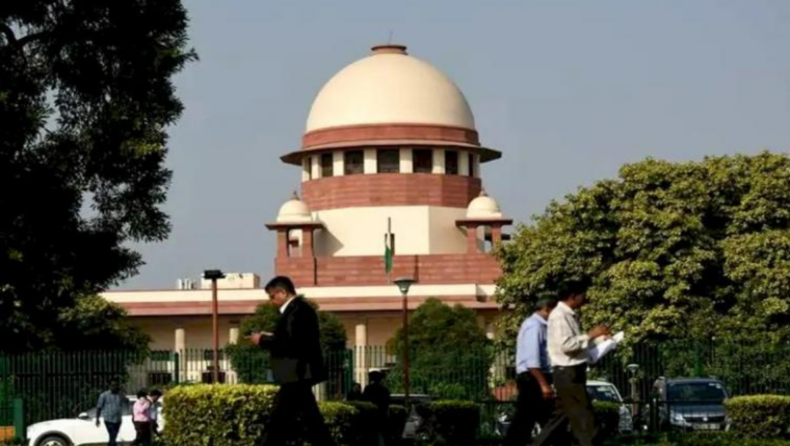On Monday, the Supreme Court ruled that “the law presumes marriage and disfavors concubinage” if a man and woman cohabit for an extended period, and that their child cannot be denied inheritance rights.
The decision was rendered in an appeal of a partition claim Kerala High Court. A property was subject to the coparcenary rights of four sons and their heirs. One of them had been in a relationship with a lady for years and had a kid. Before the courts were the matter of whether or not this boy should be considered an illegitimate child. The opposing side argued that there was no paperwork or proof to indicate that the couple had wed. They maintained that a kid resulting from such a relationship had no claim to coparcenary property.

A bench of Justices S Abdul Nazeer and Vikram Nath said “the law presumes in favor of marriage and not in a state of concubinage.”
Background
In this case, the plaintiffs who brought an action for division claimed that the land in question belonged to Kattukandi Edathil Kanaran Vaidya, who had four sons named Damodaran, Achuthan, Sekharan, and Narayanan. The first plaintiff is Damodaran’s legitimate son with Chiruthkutty, while the second plaintiff is the first plaintiff’s son.
The defendants said that all the children, except Achuthan, died as bachelors and that Achuthan’s lone son was named Karunakaran. They refuted the plaintiffs’ claim that Damodaran had married Chiruthkutty and that the first plaintiff was their son from that marriage. The trial court determined that Damodaran cohabited with Chiruthakutty for an extended period, therefore it was reasonable to believe that Damodaran married Chiruthakutty and that the first plaintiff was their son.
The Trial Court issued a preliminary decision dividing the property at issue into two portions, one of which was allocated to the plaintiffs. Accepting the appeal filed by the defendants, the High Court ruled that there was no evidence to support the extended cohabitation between the first plaintiff’s father and mother and that the papers merely established that the first plaintiff is Damodaran’s son, but not his legal son.
The appellant plaintiffs argued before the Supreme Court that the many papers they submitted would prove that Damodaran was the father of the first plaintiff and Chiruthakutty was Damodaran’s wife.
The defendants, on the other hand, argued that neither the marriage nor the protracted cohabitation was supported by any evidence.
The Supreme Court thus assessed whether there was adequate evidence to establish the husband-wife connection between Damodaran and Chiruthakutty based on their continuous cohabitation.
There would be a presumption favoring marriage.
It is well established that if a man and a woman live together as husband and wife for a long time, there is a presumption in favor of marriage. The Evidence Act’s Section 114 could be used to create such a presumption. Even though the presumption can be rebutted, the person seeking to deprive a legal relationship of its legal origin bears a heavy burden of proof.
Examining the records and evidence on file, the court determined that the plaintiffs have shown that Damodaran lived as husband and wife for an extended period. The court further remarked that the defendants had failed to refute the inference that Damodaran and Chiruthakutty were married due to their protracted cohabitation.
If a man and a woman have lived together as husband and wife for several years, there is a presumption of marriage. Although the assumption is rebuttable, anyone who seeks to deprive the connection of legal origin has a great burden to demonstrate that no marriage transpired.
This court ruled that a strong presumption of marriage exists when two partners have lived together as husband and wife for an extended period. Although the assumption is rebuttable, anyone who seeks to strip the connection of its legal basis has a hard burden.
The law favors validity and frowns against fraudulence.
Says Badri Prasad v. Dy. Director of Consolidation.
“… where a man and woman are proved to have lived together as man and wife, the law will presume, unless the contrary is proved, that they were living together in consequence of a valid marriage and not in a state of concubinage.”
Andrahennedige Dinohamy and Anr. v. Wijetunge Liyanapatabendige Balahamy.
If the parties have lived together as husband and wife for an extended length of time, it is believed that they are married. However, this assumption can be rebutted, and the duty of disproving it is on the party challenging the legal origin of the marriage. ”
Tulsa v. Durghatiya (2008 (4) SCC 520).
Under Section 114, the court has to make a presumption.
This section gives the court the power to assume certain facts about the case based on the facts we already know and can help us come to a valid conclusion. It is important to remember that it is not a must.
Assumptions can be figured out from the facts and circumstances, but not from other assumptions, using logic and the balance of probabilities. Also, assumptions are proof that can’t be argued with, but they must be made within the limits of the law.
They can be proven wrong if the person who has to prove it does so with proof. It is up to the court to carefully look at all the facts and make a decision that makes sense and is well thought out.
Code of Civil Procedure, 1908; Order XX, Rule 18-Partition suits
The Trial Courts shall list the issue for taking action under Order XX Rule 18 of the CPC promptly after passing the preliminary decision for division and individual ownership of the property, suo motu, and without necessitating the start of any separate procedures. The courts should not adjourn the subject sine die.
Code of Civil Procedure, 1908; Order XX, Rule 18-Partition suits
Partition cases: The difference between interim and final judgments A preliminary decree just announces the parties’ rights and shares, leaving provision for additional investigation to be done by the preliminary decree’s orders; and when the investigation has been completed and the parties’ rights have been ultimately decided, a final decree containing such a conclusion is required.
The Supreme Court made the following observation in dismissing the appeal:
“We are of the view that once a preliminary decree is passed by the Trial Court, the court should proceed with the case for drawing up the final decree suo motu.” After passing the preliminary decree, the Trial Court has to list the matter for taking steps under Order XX Rule 18 of the CPC. The courts should not adjourn the matter sine die, as has been done in the instant case. There is also no need to file separate final decree proceedings. In the same suit, the court should allow the concerned party to file an appropriate application to draw up the final decree. It is unnecessary to state that the suit comes to an end only when a final decree is issued. Therefore, we direct the Trial Courts to list the matter for taking steps under Order XX Rule 18 of the CPC soon after passing the preliminary decree for partition and separate possession of the property, suo motu, and without requiring the initiation of any separate proceedings. ”
Case details
Kattukandi Edathil Krishnan vs. Kattukandi Edathil Valsan 2022













